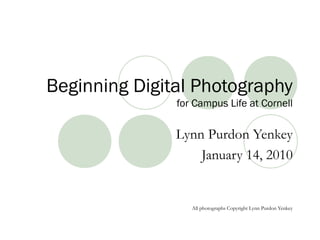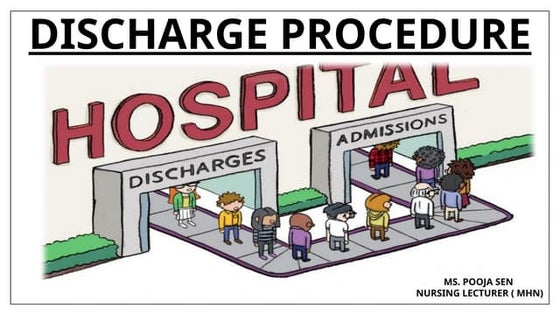Beginning Digital Photography
- 1. Beginning Digital Photography for Campus Life at Cornell Lynn Purdon Yenkey January 14, 2010 All photographs Copyright Lynn Purdon Yenkey
- 2. Intro & Overview ’ü¼ How much camera do I need? ╠²╠²(15 min) - camera options, megapixels, & storage media╠²the casual photographer needs to make quality pictures ’ü¼ Upload pictures to the computer ╠²(3 min) - camera cables vs. card readers ’ü¼ Edit pictures to crop, remove redeye, & more (15 min) - JPG compression (benefits and dangers) - demo of Picasa software for basic picture editing ’ü¼ Basic photography concepts (20 min) ŌĆōcomposition, exposure, what to think about before you click ’ü¼ Q&A ’ü¼ Resources
- 3. Mega what? ’ü¼Mega = million / pixel = light-capturing elements in a cameraŌĆÖs sensor ’ü¼2048├Ś1536 sensor elements = 3,145,728 ~ 3.1 megapixels ’ü¼ Defines the primary resolution of photos ’éĪAt the highest image quality setting ’éĪUse camera settings to lower resolution and save disk space
- 4. How many megapixels is enough? ’ü¼What is the highest image quality you want to achieve? What do you want to do with your photos? ’éĪ Web: use the lowest resolution: in camera or save a new version ’éĪ Personal prints / home printer quality: average quality settings ’éĪ Gift quality prints, cards, fine art: high quality ’ü¼Cost: more resolution costs more, but less than it used to ’éĪ Beware of too many megapixels packed into small sensors ’ü¼Memory: shooting & storage ’éĪ Get extra storage cards if you plan to shoot a lot ’éĪ Faster cards mean faster shooting & downloading (MB/s) ’éĪ Archive! External hard drives, DVDs, online storage companies
- 5. Storage Card Memory Examples 32 MB 64 MB 128 MB 256 MB 512 MB 1 GB 1 megapixel 92 180 363 730 1460 2923 2 megapixel 34 70 140 283 567 1135 3 megapixel 25 51 105 212 424 852 4 megapixel 16 32 64 128 256 512 5 megapixel 11 25 50 101 203 407 6 megapixel 10 20 40 80 160 320 7 megapixel 9 18 38 75 150 301 8 megapixel 8 16 32 64 128 256 http://www.microsoft.com/windowsxp/using/digitalphotography/expert/compactflash.mspx These numbers may vary by camera and assume using the highest quality image setting. How many images can you store on a memory card? How many will you shoot in an outing?
- 6. What size print can I make? ’ü¼What is your starting resolution? ’ü¼What is the output device? ’éĪPhoto lab: 240-300 ppi ’éĪHome printerŌĆövarying resolution possibilities Megapixels at 300 PPI at 200 PPI 2 5.8" x 3.8" 8.7" x 5.8" 3 7.1" x 4.7" 10.6" x 7.1" 4 8.2" x 5.4" 12.2" x 8.2" 5 9.1" x 6.1" 13.7" x 9.1" 6 10.0" x 6.7" 15.0" x 10.0" 8 11.5" x 7.7" 17.3" x 11.5" 12 14.1" x 9.4" 21.2" x 14.1" 16 16.3" x 10.9" 24.5" x 16.3" 22 19.1" x 12.8" 28.7" x 19.1ŌĆ£ http://www.cambridgeincolour.com/tutorials/digital-camera-pixel.htm
- 7. Other features to consider ’ü¼Get good opticsŌĆöbetter lenses make better photos ’éĪOptical zoom is better than digital zoom ’ü¼More controls mean more control ’éĪAs your skills grow, you might prefer more control ’ü¼Shutter lag: the best way to miss the moment ’éĪCompare and get the least you can find (measured in fractions of seconds) ’éĪCompensate by holding trigger half-way down to pre-focus and set exposure readings ’ü¼Battery life. Carry extras!
- 8. Uploading Images ’ü¼Camera software provided ’ü¼Camera is just another drive ’ü¼USB cable (drains camera battery) ’ü¼Digital media drives ’éĪaccommodate different card sizes ’éĪUpload faster than cables
- 9. File Compression & Color Format ’ü¼JPEG: benefits and risks ’éĪSmall, med, large in camera ’éĪŌĆ£LossyŌĆØ compression. Data is lost on each re-save. ’éĪSave a copy to edit & keep the original unchanged. ’ü¼Color space: ’éĪsRBG for the WebŌĆösmallest color gamut. Some online printers now ask for sRGB. ’éĪAdobe RGB: bigger color gamut, use for prints
- 10. Picasa Demo ’ü¼http://picasa.google.com ’éĪOrganize images on your computer ’éĪShare images on web albumsŌĆöpublic and private ’éĪEdit images ’éĪOrder prints ’éĪBe creative: movies, collages, ’éĪFree!
- 11. ExposureŌĆÖs Basic Ingredients ’ü¼ISO controls sensorŌĆÖs sensitivity to light ’éĪHigher #s for low light or fast action (ISO 400 & up) ’éĪLower #s for bright daylight, blurring, finer quality ’ü¼Aperture / f - stop ’éĪControls volume of light reaching the sensor (like a faucet on high or low) ’éĪControls depth of fieldŌĆöhow much or little is in focus ’ü¼Shutter speed ’éĪControls how long light reaches the sensor ’éĪControls appearance of movementŌĆöblurs or stops action
- 12. ISO ’ü¼Controls sensor sensitivity to light ’éĪNext level up means twice as sensitive to light ’éĪHigh number = high light sensitivity ’ü¼Enables faster shutter speeds or smaller apertures ’ü¼Higher ISO adds noise (ŌĆ£graininessŌĆØ in film) ’ü¼ISO 400 typical for sports outside ’ü¼ISO 1600 typical for low light ’éĪLow number = low sensitivity ’ü¼Enables long shutter speeds or wider apertures ’ü¼Use to intentionally blur or defocus background (DoF) ’ü¼ISO 100 or 200 for bright daylight with slow-moving subjects or stills
- 13. Aperture ’ü¼How much light enters the lens opening ’ü¼Moving up or down one f -stop halves or doubles the lens opening (and the amount of light entering lens) f /2.8, f /4, f /5.6, f /8, f /11, f /16, etc. ’ü¼Inverse of shutter speedŌĆölarge aperture (smaller number) usually needs faster shutter speed ’ü¼ŌĆ£Aperture PriorityŌĆØ ŌĆō Av or A mode
- 14. Aperture and Depth of Field ’ü¼DoF is a defining characteristic of photography ’ü¼Low f - stop = more light, less DoF High f - stop = less light, more DoF ’éĪf /2.8 ~ ŌĆ£wide openŌĆØ: smaller DoF (less is in focus) ’éĪf /16: larger DoF: 2 ft to infinity in focus ’ü¼Focus to create interest ’éĪget close and zoom or use macro
- 15. Using Depth of Field ’ü¼ Small apertures (f #) shorten the area of focus, create blurred backgrounds (ŌĆ£Shallow depth of fieldŌĆØ) ’ü¼ Centers attention on what is sharp.
- 16. Shutter Speed and Movement ’ü¼Shutter speeds double (approx.) with each setting. 1 sec, ┬╝, ┬Į, 1/8, 1/15, 1/30, 1/60, 1/125, 1/250, 1/500, 1/1000 ’ü¼Inverse of apertureŌĆö faster shutter speed needs wider aperture (smaller f number) ’ü¼Do you want to show movement or stop action? ’ü¼Low light needs longer time ’ü¼ŌĆ£Shutter PriorityŌĆØ ŌĆō Tv mode ’éĪShutter speed- based exposure
- 17. f /16 Rule ’ü¼Bright daylight ’ü¼Set shutter speed equal to ISO ’éĪISO 200, then shutter is 1/200 ŌĆō 1/250 sec ’ü¼Aperture = f /16 ’ü¼Shift aperture + shutter up or down (inversely) to get the desired setting. For ex: 1/1000 sec @ f /8
- 18. Shutter Speed and Movement ’ü¼Increase ISO to improve stop action or shoot in low light ’ü¼Chances of blur increase with low shutter speeds ’ü¼Pre-focus where you want to stop the action ’ü¼Experiment with showing movement or stopping it
- 19. Composition: Rule of Thirds ’ü¼A rule in visual arts to create balanced, interesting images ’ü¼Divide the image into thirds vertically and horizontally. ’ü¼Place the point of interest at one of the red intersections. ’ü¼Place horizon lines at thirds, not in the middle. ’ü¼ Break the rule sometimes. http://digital-photography-school.com/blog/rule-of-thirds/
- 20. Rule of Thirds Careful composition improves even casual snapshots.
- 21. Lens Choices / Focal Length ’ü¼How much do you want to show? ’ü¼Wide angles ’éĪAppearance of a larger depth of field so more is in focus ’éĪWidest angles can distort corners ’ü¼Normal ’éĪSimilar view to what the human eye sees ’ü¼Zoom/Telephoto ’éĪCompresses the subject and background ’éĪAppearance of shorter depth of field ’éĪHand shake is also magnified, so you tend to require faster shutter speeds (& higher ISO)
- 22. Wide vs. Telephoto Can you see the giraffes?
- 23. Wide Angles Wide angles can distort what is closest to the lens Corner distortion, but overall effect OK
- 24. Change Your Point of View How do you really see the scene? What do you want the picture to make the viewer feel ?
- 25. Get Closer to Your Subjects
- 26. Be a lifelong photography student. ’ü¼Think about what you want to come away with. ’ü¼Get to know your camera. ’ü¼ExperimentŌĆödigital images are free, so experiment & learn from mistakes. ’ü¼Give self-assignments: capture blur, mood in low light, fast action, different DoFŌĆ” try something new! ’ü¼Get close to your subjects. Move around! ’ü¼Have fun!
- 27. Resources Get Prints Online ’ü¼ www.mpix.com ’ü¼ www.kodakgallery.com or Kodak Kiosk in stores ’ü¼ www.picasa.google.com ’ü¼ www.walmart.com ’ü¼ http://photos.live.com ’ü¼ www.flickr.com ’ü¼ www.shutterfly.com ’ü¼ www.snapfish.com Camera Review Sites ’ü¼ http://reviews.cnet.com/digital-camera-reviews ’ü¼ http://www.bestinclass.com/digital-cameras ’ü¼ http://www.dcresource.com/ ’ü¼ http://www.dpreview.com/reviews/compare.asp Exposure ’ü¼ http://digital-photography-school.com/blog/learning-exposure-in-digital-photography/ Megapixels ’ü¼ www.digicamguides.com/learn/megapixels.html ŌĆō a good description of how mega you need to get ’ü¼ http://www.digicamguides.com/print/ppi-print-size.html ŌĆō megapixels and printing ’ü¼ http://en.wikipedia.org/wiki/Digital_camera#Image_resolution ŌĆō a good description and table of different sensors and their resolutions ’ü¼ http://www.digicamguides.com/learn/digital-camera-terms.html ŌĆō general digital & photo terms Shutter Lag ’ü¼ These specs change, so please read latest manufacturer information. ’ü¼ www.cameras.co.uk/html/shutter-lag-comparisons.cfm ’ü¼ www.nytimes.com/2007/05/10/technology/10basics.html?_r=2&oref=slogin
Editor's Notes
- #5: 1000 x 667 JPG 72 dpi at 65% quality is 193 KB






























































































